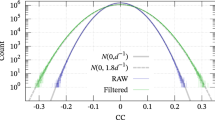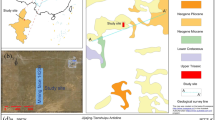Abstract
ELECTRICAL resistivity surveys are all based on the method of Wenner1. A current, I, is passed into the earth through one point electrode and returns to the apparatus through a second. The potential difference between two points on the earth‘s surface, V, is measured. Let Then R can be related to the resistivity of the earth and the electrode spacing. Usually the four electrodes used are spaced in a straight line, and frequently a symmetrical arrangement is used. If the distance between the current electrodes is 2a and between the potential electrodes is 2αa for a symmetrical arrangement, it is easily shown2 that, for a homogeneous earth, the resistivity ρ is given by If the earth is not homogeneous, the value of ρ obtained from (2) will vary with a. This variation will be related to the nature of the earth, and hence the usefulness of the method.
This is a preview of subscription content, access via your institution
Access options
Subscribe to this journal
Receive 51 print issues and online access
$199.00 per year
only $3.90 per issue
Buy this article
- Purchase on Springer Link
- Instant access to full article PDF
Prices may be subject to local taxes which are calculated during checkout
Similar content being viewed by others
References
Wenner, F., U.S. Bur. Stand. Sci. Paper, 258, 469 (1917).
Hummel, J. W., Amer. Inst. Min. and Met. Eng., Tech. Paper No. 418.
Tagg, G. F., Amer. Inst. Min. and Met. Eng., Tech. Paper No. 755.
Roman, I., U.S. Dept. of Commerce, Bur. of Mines, Tech. Paper No. 502.
Author information
Authors and Affiliations
Rights and permissions
About this article
Cite this article
HOUGH, J. Interpretation of Data from Electrical Resistivity Geophysical Surveys. Nature 161, 812–813 (1948). https://doi.org/10.1038/161812a0
Issue Date:
DOI: https://doi.org/10.1038/161812a0
This article is cited by
-
Interpretation of Data from Electrical Resistivity Geophysical Surveys
Nature (1948)
-
[Letters to Editor]
Nature (1948)
Comments
By submitting a comment you agree to abide by our Terms and Community Guidelines. If you find something abusive or that does not comply with our terms or guidelines please flag it as inappropriate.



